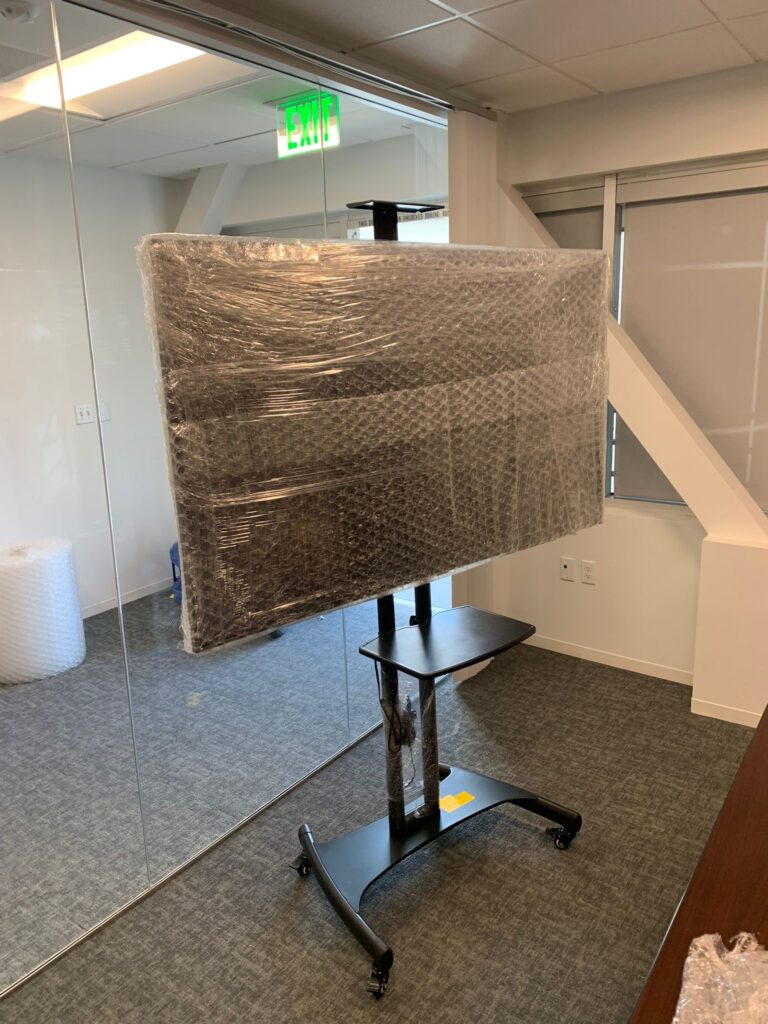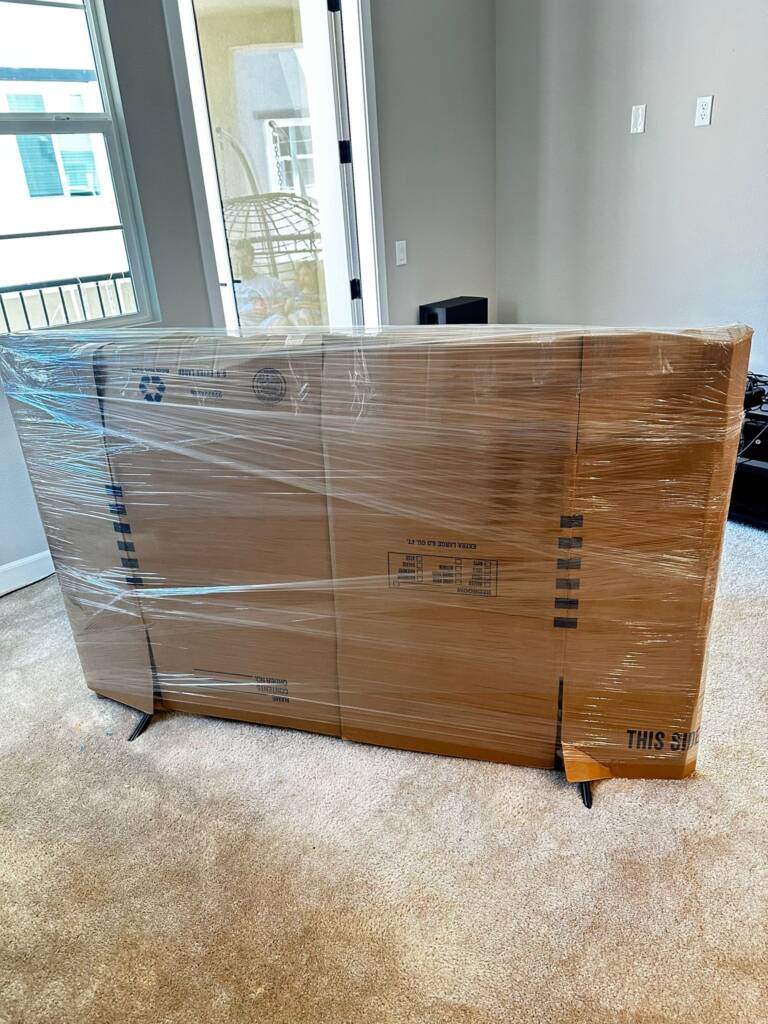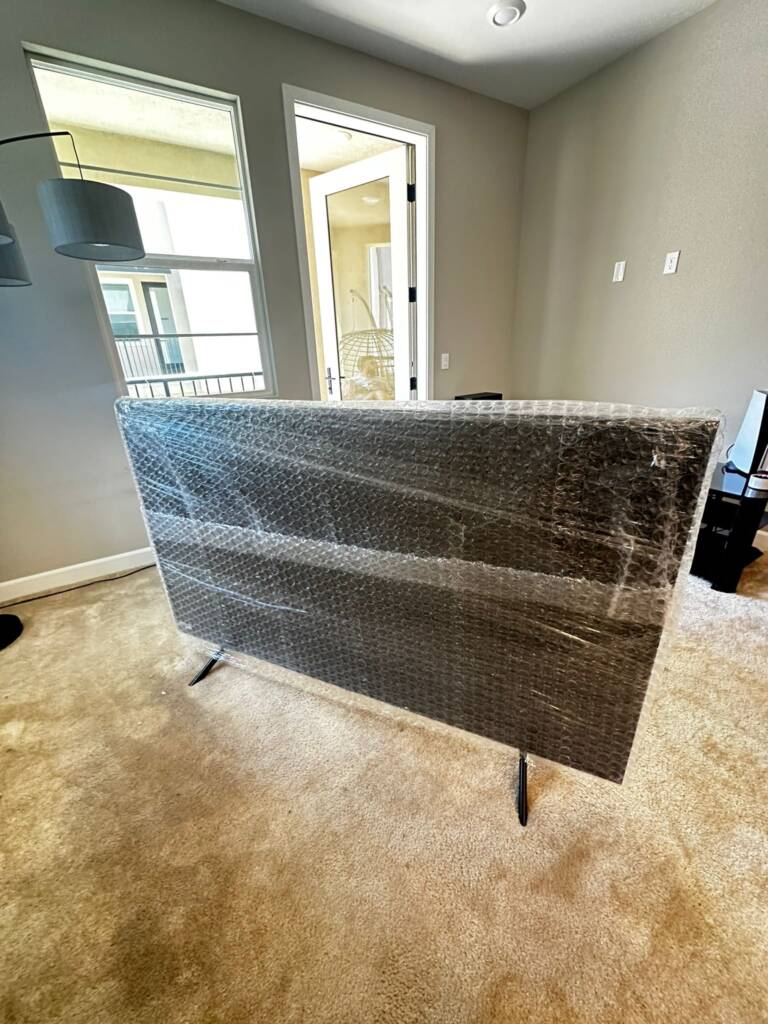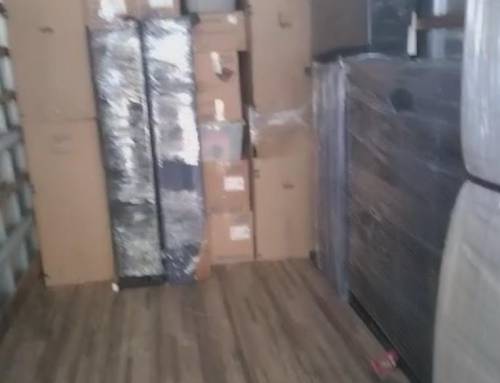How to Safely Pack a TV Before Moving
Televisions are delicate, high-value items.
During a relocation, ensuring the safety of your television is paramount; improper packing can lead to irreversible damage.
To mitigate this risk, it is critical to adhere to the proper packing techniques—utilizing sturdy, protective materials and precise methods to shield your screen and electronics during the moving process.
Safety begins with preparation.
Choosing the Right Packing Materials
Selecting optimal packaging materials is fundamental to securing your television’s integrity. Prioritize the acquisition of specialized television boxes, which are crafted to fit various screen sizes. Utilize high-quality, cushioning materials such as bubble wrap, foam padding, and packing peanuts to provide substantial shock absorption. For optimal protection, consider using anti-static bubble wrap to prevent any electrical charge that could potentially harm the electronics inside.
In addition to these buffer materials, invest in strong, wide packing tape designed for heavy-duty purposes to seal the box steadfastly. Ensure that you also have soft, non-abrasive wraps, like a thick blanket or specially designed TV cover, to initially encase the screen and prevent scratches or pressure marks during transit.
Utilizing Original Packaging
The safest method for packing your TV is to use its original packaging, designed to protect its unique dimensions.
Original packaging shields your TV with styrofoam inserts molded specifically for your model, providing unparalleled protection during transit.
If original packaging is unavailable, opt for a television moving box with adjustable inserts simulating the original protections, ensuring the screen and electronics are snug and secure.
Parkaging your valued electronic in anything other than its tailored design increases the risk; hence, original boxing remains the preferred method to mitigate transit hazards.
Alternative Protective Supplies
When the original packaging is not an option, alternative materials are necessary to ensure your television’s safety.
- Bubble Cushioning Wrap: For wrapping the screen and providing a protective air cushion.
- Plush Moving Blankets: These can be wrapped around the television for a padded barrier.
- Furniture Pads: To buffer the TV against impacts and vibrations during transport.
- Corrugated Cardboard Sheets: Cut and fit these around the screen to add a rigid, protective layer.
- Stretch Plastic Wrap: Great for securing the padding and preventing dust and debris.
- Packing Peanuts: For filling any void spaces within the box to restrict movement.
- Edge Protectors: Applied on the corners to safeguard against sharp impacts.
Using these materials properly requires a careful approach and layering technique.
Selecting the right combination of alternative supplies can be just as effective as original packaging in preventing damage.
Understanding the properties of each material and the level of protection they afford is crucial to safeguarding your television throughout the move.
Preparing Your TV for Packing

Before you start the physical process of packing, ensure that you take photographs of your TV’s setup, particularly the wiring configuration, which will be invaluable when you’re reassembling at your new location. Disconnect all cables, store them separately in a clearly marked bag, and affix any provided cable management brackets back onto the TV.
Clean the screen and casing with a soft, dry microfiber cloth to remove dust and debris that could potentially scratch the surface during movement. Retain the original stand or mounting materials, as these are designed to hold the TV securely and may be needed if your new installation mirrors the old one.
Proper Cleaning Techniques
Diligently clearing dust from your television sets the stage for a safe relocation. Begin by gently wiping the screen using a new, dry microfiber cloth.
Minimize the risk of scratching by avoiding harsh cleaning chemicals; instead, consider a pre-mixed solution made especially for electronic screens if stubborn spots persist. Spray the solution onto the cloth—not directly onto the TV—to apply.
For persistent stains, use the recommended solution sparingly, in a circular motion, ensuring not to exert undue pressure on the screen’s delicate surface. Pay attention to the frame and ventilation areas, as accumulated dust can impede airflow.
While the screen requires finesse, the exterior can usually withstand a more thorough cleaning. Use a slightly dampened cloth with water or a gentle cleaning solution to address the TV casing, avoiding any ports or openings.
Once cleaned, ensure that the television is completely dry before proceeding with packing. Lingering moisture could lead to damage during the moving process or foster an environment for mold development.
Securing Loose Components
Prior to packing, detach all cables and accessories from your television. These peripherals can become hazardous during transit if left connected.
Including HDMI cables and power cords, each should be individually wrapped with care. Use Velcro ties or zip ties for secure and orderly bundling, protecting against damage and tangling.
Mindful organization of these components is crucial, as is labeling each cable. This not only facilitates easy reconnection at your destination but also prevents confusion that could lead to missteps or connection errors.
When placing these detached cables with the TV, consider cushioning them in bubble wrap. This protective layer will minimize any potential impacts, vibrations, or abrasive movements during the move.
Contained within a dedicated box separated from other moving items, the bundled cables will remain safe and ready for reassembly upon arrival at your new location.
Packing the TV Securely

When protecting your own visual entertainment investment, employ a heavy-duty moving box, specifically designed for large electronics, that mirrors the size of your television—too large and your TV might shift; too snug and pressure can damage the screen. The inclusion of foam corner protectors provides an extra safeguard, creating a barrier between the TV and external forces which could inflict harm.
For optimal protection during the relocation of a flat-screen TV, consider a layering strategy that starts with a “screen shield”. This is a padded cover that fits over the face of the TV, offering an additional buffer against scratches and impacts. To prevent movement within the box, fill the remaining voids with anti-static bubble wrap or packing peanuts. When sealing the box, reinforce the top and bottom with high-quality packing tape, ensuring that the television remains immobile throughout the transit, immune to the jostles and jounces of the moving process.
Wrapping for Screen Protection

Begin by cleaning the television screen gently to remove dust and debris, which, if left unabated, could scratch the surface during the wrapping process.
Utilizing a microfiber cloth, ensure that the screen is impeccably clean and dry to avoid trapping moisture, which could lead to screen damage during transit.
Next, procure a high-quality screen protector made specifically for televisions, adhering it carefully to shield the most delicate component of your device against potential scratches and dings.
Surround the screen with a blanket or foam wrap, which provides a cushioning layer against bumps, securing it with tape that doesn’t adhere directly to the television to preclude residue.
In the final preparation step, drape a large, lightweight, anti-static covering over the entire television, safeguarding it against dust and static electricity that could damage electronic components.
Box Packing Best Practices
Select a box that corresponds precisely to the size of your television, ensuring minimal movement within while providing enough space for appropriate cushioning materials.
Secure the base with high-quality packing tape for added stability.
Box reinforcement is of paramount importance—strengthen the bottom of the box with extra tape, creating a supportive grid that minimizes risk of structural failure under the weight of your television.
Pack the sides around the television with shock-absorbing materials such as bubble wrap, foam sheets, or crumpled paper to resist impact forces that might occur during transportation. Ensure these materials are in place without exerting pressure on the screen or the frame, maintaining the integrity of your set.
Handling and Transporting Your TV
When the time comes to move your television, the transportation phase becomes critical. Prioritize gentle and deliberate handling to prevent any inadvertent pressure on screens or frames that could induce damage. It is essential to maintain the TV in an upright position during transit to coincide with its natural orientation and minimize internal stress. Utilize a vehicle with sufficient space, where the television can be securely positioned, avoiding any excessive movement or vibration. Moreover, when lifting the TV, always keep your back straight and lift with your legs, not your back, to avoid personal injury, while ensuring the safety of your valuable electronic.
Safe Lifting and Carrying
Proper mechanics are essential for safe lifting.
To prevent injury and damage to your television, correct lifting techniques must be employed. By bending at the hips and knees, you maintain a low center of gravity and promote balance. This stance also shields your back muscles from undue strain, allowing the stronger leg muscles to bear the bulk of the weight. Furthermore, keeping the load close to your core enhances stability and reduces the risk of tipping or dropping the TV.
Never lift a television set by yourself.
Engage a helper when carrying your television – it’s not a solo task. This ensures stability and reduces the likelihood of strain or injury. Partner lifting mandates good communication and coordinated movements to ensure that the load is evenly distributed and remains steady throughout the journey.
Transportation is as vital as the lifting itself.
Once lifted, a TV must be carried in a secure manner. To do this, pursue a steady and unhurried pace, carefully navigating through doorways and around corners to avoid jarring or bumping the set against obstacles. This concordance in motion greatly diminishes the chances of mishap.
Rely on practice and expertise for a seamless move.
The best practices in television lifting and carrying are generally reinforced through experience. Consult with professional movers, who are updated with industry-leading techniques as of early 2023, for a seamless relocation. These specialists use proven methods to protect your electronics, employing sophisticated equipment and understanding the intricacies involved in handling high-value items.
Vehicle Loading Strategies
When positioning your television inside the moving vehicle, priority is given to stability and cushioning. This includes securing the television with straps, ensuring it’s surrounded by soft padding to mitigate movements during transportation.
Ideally, place the television upright during transit, mimicking its natural position. Orientation matters, as laying screens flat can cause undue pressure.
The choice of vehicle also influences safe transit. Select a moving truck with adequate space and suspension (to prevent jostling) that is conducive to the safe transportation of delicate electronics.
Ensure there is no direct pressure on the screen or the edges of the television. Isolate it from objects that might shift, slide, or fall during the move.
Pack other heavy items first, creating a stable base on which to place the television. Strategically placed heavier items prevent the TV from shifting in transit and mitigate the risk of collision with other objects.
Ultimately, vehicle loading is the mover’s domain of expertise. Engaging with professionals who are adept in safe transit practices ensures the well-being of your television throughout the journey.
How Cube Moving can move it for you!
At Cube Moving, we recognize the distinctiveness of each electronic item, especially a television, and the meticulous care it demands to be moved safely.
Our professionals, equipped with an intimate knowledge of electronic packing, utilize custom-designed moving boxes that offer fortified corners for additional protection, and shock-absorbent padding that snugly encases the television. This not only ensures the screen remains intact but also guards against unexpected jolts that may occur during transport. With proactive measures and expert handling, we transform the risk-laden journey into a secure passage for your cherished device.
Moreover, the orientation of your TV is a priority in our moving protocol. We guarantee upright transport, preserving the manufacturer’s intended posture to spare it from unnecessary strain. Our fleet consists of specially outfitted trucks with advanced suspension systems, ensuring a smooth transit that mimics the serene environment of your living room.
In conclusion, entrusting Cube Moving with your television guarantees a seamless transition from old to new premises. Our commitment to electronic safety is reflected in our strategic loading techniques, which involve placing weighty objects first to create a secure foundation, thus isolating the television. Like the maestros of a symphony, we orchestrate the movement of every item to minimize any possible disruption, securing your electronics amid a sanctuary of stability throughout their journey.






Leave A Comment